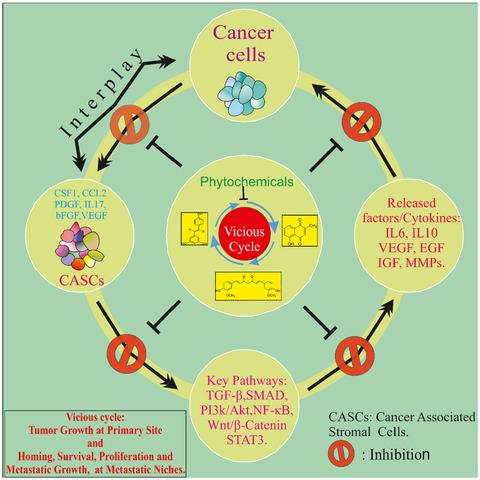当前位置:
X-MOL 学术
›
J. Food Biochem.
›
论文详情
Our official English website, www.x-mol.net, welcomes your
feedback! (Note: you will need to create a separate account there.)
Molecular insights into phytochemicals-driven break function in tumor microenvironment
Journal of Food Biochemistry ( IF 3.5 ) Pub Date : 2021-07-05 , DOI: 10.1111/jfbc.13824 Priyanshi Rana 1 , Amarjeet Shrama 1 , Chandi C Mandal 1
Journal of Food Biochemistry ( IF 3.5 ) Pub Date : 2021-07-05 , DOI: 10.1111/jfbc.13824 Priyanshi Rana 1 , Amarjeet Shrama 1 , Chandi C Mandal 1
Affiliation

|
Advanced knowledge about the role of tumor microenvironment (TME) in cancer progression has opened various ways to target the vast signaling pathways for cancer treatment. Failures of the currently used drugs have raised out the need to look for novel drugs which can target various crucial aspects of cancer progression (e.g., angiogenesis, uncontrolled cell division, and metastasis). Phytochemicals behaving as potent anticancer agents shows promise as therapeutics. Various phytochemicals, such as curcumin, Epigallocatechin Gallate (EGCG), resveratrol, plumbagin, genistein, and others, have been identified with modulatory effect on TME. These phytochemicals often target the molecular pathways that reside in the tumor vicinity associated with endothelial cells, cancer-associated fibroblasts, immune cells, mesenchymal stem cells, other cell types, vascular and lymphatic networks, and extracellular matrix which are important for tumor progression and development. Some phytochemicals also target the internal signaling pathways, including STAT3, NF-қB, ERK-1/2, and PI3K/Akt signaling of noncancer cell, residing in the microenvironment, and thus inhibiting the supportive effect from these cells in tumor development. However, much information needs to be acquired before using these phytochemicals in cancer treatment. The primary objective of this review is to provide a better knowledge about the role of TME in cancer progression and development, focusing on the different targets which can be used for therapeutic approach, and then to give a brief account on some known phytochemicals to date, which have shown remarkable TME modulatory effects.
中文翻译:

对肿瘤微环境中植物化学物质驱动的断裂功能的分子见解
关于肿瘤微环境 (TME) 在癌症进展中的作用的先进知识为靶向治疗癌症的巨大信号通路开辟了各种途径。当前使用的药物的失败引发了寻找可以针对癌症进展的各个关键方面(例如,血管生成、不受控制的细胞分裂和转移)的新型药物的需要。作为有效抗癌剂的植物化学物质显示出作为治疗剂的前景。各种植物化学物质,如姜黄素、表没食子儿茶素没食子酸酯 (EGCG)、白藜芦醇、白花素、染料木素等,已被确定对 TME 具有调节作用。这些植物化学物质通常针对与内皮细胞、癌症相关成纤维细胞、免疫细胞、间充质干细胞、其他细胞类型相关的肿瘤附近的分子途径,血管和淋巴网络,以及对肿瘤进展和发展很重要的细胞外基质。一些植物化学物质还针对存在于微环境中的非癌细胞的内部信号通路,包括 STAT3、NF-қB、ERK-1/2 和 PI3K/Akt 信号通路,从而抑制这些细胞在肿瘤发展中的支持作用。然而,在将这些植物化学物质用于癌症治疗之前,需要获得很多信息。本综述的主要目的是更好地了解 TME 在癌症进展和发展中的作用,重点关注可用于治疗方法的不同靶点,然后简要介绍一些迄今为止已知的植物化学物质,已显示出显着的 TME 调节作用。和细胞外基质,它们对肿瘤的进展和发展很重要。一些植物化学物质还针对存在于微环境中的非癌细胞的内部信号通路,包括 STAT3、NF-қB、ERK-1/2 和 PI3K/Akt 信号通路,从而抑制这些细胞在肿瘤发展中的支持作用。然而,在将这些植物化学物质用于癌症治疗之前,需要获得很多信息。本综述的主要目的是更好地了解 TME 在癌症进展和发展中的作用,重点关注可用于治疗方法的不同靶点,然后简要介绍一些迄今为止已知的植物化学物质,已显示出显着的 TME 调节作用。和细胞外基质,它们对肿瘤的进展和发展很重要。一些植物化学物质还针对存在于微环境中的非癌细胞的内部信号通路,包括 STAT3、NF-қB、ERK-1/2 和 PI3K/Akt 信号通路,从而抑制这些细胞在肿瘤发展中的支持作用。然而,在将这些植物化学物质用于癌症治疗之前,需要获得很多信息。本综述的主要目的是更好地了解 TME 在癌症进展和发展中的作用,重点关注可用于治疗方法的不同靶点,然后简要介绍一些迄今为止已知的植物化学物质,已显示出显着的 TME 调节作用。一些植物化学物质还针对存在于微环境中的非癌细胞的内部信号通路,包括 STAT3、NF-қB、ERK-1/2 和 PI3K/Akt 信号通路,从而抑制这些细胞在肿瘤发展中的支持作用。然而,在将这些植物化学物质用于癌症治疗之前,需要获得很多信息。本综述的主要目的是更好地了解 TME 在癌症进展和发展中的作用,重点关注可用于治疗方法的不同靶点,然后简要介绍一些迄今为止已知的植物化学物质,已显示出显着的 TME 调节作用。一些植物化学物质还针对存在于微环境中的非癌细胞的内部信号通路,包括 STAT3、NF-қB、ERK-1/2 和 PI3K/Akt 信号通路,从而抑制这些细胞在肿瘤发展中的支持作用。然而,在将这些植物化学物质用于癌症治疗之前,需要获得很多信息。本综述的主要目的是更好地了解 TME 在癌症进展和发展中的作用,重点关注可用于治疗方法的不同靶点,然后简要介绍一些迄今为止已知的植物化学物质,已显示出显着的 TME 调节作用。从而抑制这些细胞在肿瘤发展中的支持作用。然而,在将这些植物化学物质用于癌症治疗之前,需要获得很多信息。本综述的主要目的是更好地了解 TME 在癌症进展和发展中的作用,重点关注可用于治疗方法的不同靶点,然后简要介绍一些迄今为止已知的植物化学物质,已显示出显着的 TME 调节作用。从而抑制这些细胞在肿瘤发展中的支持作用。然而,在将这些植物化学物质用于癌症治疗之前,需要获得很多信息。本综述的主要目的是更好地了解 TME 在癌症进展和发展中的作用,重点关注可用于治疗方法的不同靶点,然后简要介绍一些迄今为止已知的植物化学物质,已显示出显着的 TME 调节作用。
更新日期:2021-09-06
中文翻译:

对肿瘤微环境中植物化学物质驱动的断裂功能的分子见解
关于肿瘤微环境 (TME) 在癌症进展中的作用的先进知识为靶向治疗癌症的巨大信号通路开辟了各种途径。当前使用的药物的失败引发了寻找可以针对癌症进展的各个关键方面(例如,血管生成、不受控制的细胞分裂和转移)的新型药物的需要。作为有效抗癌剂的植物化学物质显示出作为治疗剂的前景。各种植物化学物质,如姜黄素、表没食子儿茶素没食子酸酯 (EGCG)、白藜芦醇、白花素、染料木素等,已被确定对 TME 具有调节作用。这些植物化学物质通常针对与内皮细胞、癌症相关成纤维细胞、免疫细胞、间充质干细胞、其他细胞类型相关的肿瘤附近的分子途径,血管和淋巴网络,以及对肿瘤进展和发展很重要的细胞外基质。一些植物化学物质还针对存在于微环境中的非癌细胞的内部信号通路,包括 STAT3、NF-қB、ERK-1/2 和 PI3K/Akt 信号通路,从而抑制这些细胞在肿瘤发展中的支持作用。然而,在将这些植物化学物质用于癌症治疗之前,需要获得很多信息。本综述的主要目的是更好地了解 TME 在癌症进展和发展中的作用,重点关注可用于治疗方法的不同靶点,然后简要介绍一些迄今为止已知的植物化学物质,已显示出显着的 TME 调节作用。和细胞外基质,它们对肿瘤的进展和发展很重要。一些植物化学物质还针对存在于微环境中的非癌细胞的内部信号通路,包括 STAT3、NF-қB、ERK-1/2 和 PI3K/Akt 信号通路,从而抑制这些细胞在肿瘤发展中的支持作用。然而,在将这些植物化学物质用于癌症治疗之前,需要获得很多信息。本综述的主要目的是更好地了解 TME 在癌症进展和发展中的作用,重点关注可用于治疗方法的不同靶点,然后简要介绍一些迄今为止已知的植物化学物质,已显示出显着的 TME 调节作用。和细胞外基质,它们对肿瘤的进展和发展很重要。一些植物化学物质还针对存在于微环境中的非癌细胞的内部信号通路,包括 STAT3、NF-қB、ERK-1/2 和 PI3K/Akt 信号通路,从而抑制这些细胞在肿瘤发展中的支持作用。然而,在将这些植物化学物质用于癌症治疗之前,需要获得很多信息。本综述的主要目的是更好地了解 TME 在癌症进展和发展中的作用,重点关注可用于治疗方法的不同靶点,然后简要介绍一些迄今为止已知的植物化学物质,已显示出显着的 TME 调节作用。一些植物化学物质还针对存在于微环境中的非癌细胞的内部信号通路,包括 STAT3、NF-қB、ERK-1/2 和 PI3K/Akt 信号通路,从而抑制这些细胞在肿瘤发展中的支持作用。然而,在将这些植物化学物质用于癌症治疗之前,需要获得很多信息。本综述的主要目的是更好地了解 TME 在癌症进展和发展中的作用,重点关注可用于治疗方法的不同靶点,然后简要介绍一些迄今为止已知的植物化学物质,已显示出显着的 TME 调节作用。一些植物化学物质还针对存在于微环境中的非癌细胞的内部信号通路,包括 STAT3、NF-қB、ERK-1/2 和 PI3K/Akt 信号通路,从而抑制这些细胞在肿瘤发展中的支持作用。然而,在将这些植物化学物质用于癌症治疗之前,需要获得很多信息。本综述的主要目的是更好地了解 TME 在癌症进展和发展中的作用,重点关注可用于治疗方法的不同靶点,然后简要介绍一些迄今为止已知的植物化学物质,已显示出显着的 TME 调节作用。从而抑制这些细胞在肿瘤发展中的支持作用。然而,在将这些植物化学物质用于癌症治疗之前,需要获得很多信息。本综述的主要目的是更好地了解 TME 在癌症进展和发展中的作用,重点关注可用于治疗方法的不同靶点,然后简要介绍一些迄今为止已知的植物化学物质,已显示出显着的 TME 调节作用。从而抑制这些细胞在肿瘤发展中的支持作用。然而,在将这些植物化学物质用于癌症治疗之前,需要获得很多信息。本综述的主要目的是更好地了解 TME 在癌症进展和发展中的作用,重点关注可用于治疗方法的不同靶点,然后简要介绍一些迄今为止已知的植物化学物质,已显示出显着的 TME 调节作用。











































 京公网安备 11010802027423号
京公网安备 11010802027423号